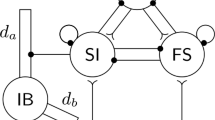Abstract
A major problem that researchers attempting to elaborate mathematical models of neurophysiological and/or psychophysiological processes are confronted with is the identification of the mechanisms that give rise, in a neural network, to oscillatory behavior, either spontaneous or induced by external stimuli. The present work starts by considering a network model of a central pattern generator (CPG), introduced by Sompolinsky and co-authors. The present authors try to generalize this model to a wider range of biological situations, by introducing into it dynamic adjustments of connections among the processing units. Although the study performed so far is quite preliminary, some analytical considerations can be presented, supported by the results of numerical simulations, which show always a relaxation of the network toward specific stable states.
Similar content being viewed by others
References
Dehaene S, Changeux JP, Nadal JP (1987) Neural networks that learn temporal sequences by selection. Proc Natl Acad Sci USA 84:2727–2731.
Gerstein GL, Bedenbaugh P, Aertsen MHJ (1989) Neuronal assemblies, IEEE Trans Biomed Eng 36/1:4–14
Getting PA, Dekin MS (1985) Comparative analysis of invertebrate central pattern generator. In: Cohen AH, Rossignol S, Grillner S (eds) Neural control of rhythmic movements in vertebrates. Wiley, New York, pp 101–128
Hartline DK (1979) Pattern generation in the lobster (Palinurus) stomatogastric ganglion. II. Pyloric network simulation. Biol Cybern 33:223–236
Hendin O, Horn D, Usher M (1991) Chaotic behavior of a neural network with dynamical thresholds. Int J Neural Syst 1:327–335
Hopfield JJ (1982) Neural networks and physical systems with emergent collective computational abilities. Proc Natl Acad Sci USA 79:2554–2558
Horn D, Usher M (1989) Neural networks with dynamical thresholds. Phys Rev [A] 40:1036–1044
Kleinfeld D, Sompolinsky H (1988) Associative neural network model for the generation of temporal patterns: theory and application to central pattern generators. Biophys J 54:1039–1051
Kleinfeld D, Sompolinsky H (1989) Associative network models for central pattern generators. In: Koch C, Segev I (eds) Methods of neuronal modelings. From synapses to networks. MIT Press, Cambridge, Mass, pp 195–246
Magleby KL (1987) Short-term changes in synaptic efficacy. In: Edelman GM, Gall WE, Cowan WM (eds) Synaptic function. Wiley, New York, pp 21–56
Selverston AI (1985) Model neural networks and behavior. Plenum, New York
Selverston AI, Moulins M (1986) The crustacean stomatogastric system. Springer, New York Berlin Heidelberg
Sompolinsky H, Kanter I (1986) Temporal association in asymmetric neural networks. Phys Rev Lett 57:2861–2864
Sutton JP, Mamelak AN, Hobson JA (1992) Network model of statedependent sequencing. Adv Neural Inf Process 4:283–290
Author information
Authors and Affiliations
Rights and permissions
About this article
Cite this article
Nicole, S., Pessa, E. A network model with auto-oscillating output and dynamic connections. Biol. Cybern. 70, 275–280 (1994). https://doi.org/10.1007/BF00197608
Received:
Accepted:
Issue Date:
DOI: https://doi.org/10.1007/BF00197608




